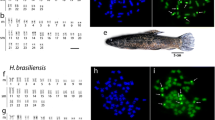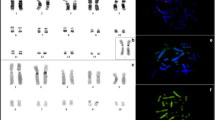Abstract
A karyological study ofTrachurus trachurus andT. mediterraneus (Perciformes: Carangidae) was conducted by standard, fluorochrome staining (CMA3, mithramycin, quinacrine mustard, DAPI), C-, Ag-NOR, and Alu-I banding methods. The karyotypes of both species consisted of 2n = 48 chromosomes, but of different FN:T. trachurus possessed a chromosome complement of 2 metacentric and 46 acrocentric elements, fundamental number (FN) = 50 andT. mediterraneus, a chromosome complement of 4 metacentric, 4 submetacentric, 14 subtelocentric and 26 acrocentric chromosomes, FN = 70. In neither of the two taxa investigated were heteromorphic sex chromosomes observed. The nucleolar organizer region was interstitially located on the long arm of the Ist pair of chromosomes in both species, intermediate inT. mediterraneus and subterminal inT. trachurus. Constitutive heterochromatin was found in nearly all centromeric and telomeric regions inT. trachurus; inT. mediterraneus it formed less intense telomeric and centromeric bands and thin interstitial bands on eight chromosome pairs. In addition, the C-positive material reacted differently to the digestion with endonuclease Alu-l in the two species. The results are discussed and compared with karyological data known for other species of Carangidae.
Similar content being viewed by others
References
Amores A, Martinez G, Reina J, Alvarez MC (1993) Karyotype, C-banding, and Ag-NOR analysis inDiplodus bellottii (Sparidae, Perciformes). Intra-individual polymorphism involving heterochromatic regions. Genome 36: 672–675
Arneri E (1984) Nota preliminare sulla biologia delle specie del genereTrachurus (T. mediterraneus, T. trachurus, T. picturatus) in Adriatico. Nova Thalassia 6: 459–464
Caputo V, Odierna G, Aprea G, Capriglione T (1993)Eumeces algeriensis, a full species of the E. schneiderii group (Scincidae): karyological and morphological evidence. Amphibia-Reptilia 14: 187–193
Coates DJ, Shaw DD (1984) The chromosomal component of reproductive isolation in the grasshopperCaledia captiva. III. Chiasma distribution pattern in a new chromosomal taxon. Heredity 53: 85–100
Das NK, Prasad R, Das CC (1980) Chromosomes of four species of marine fishes (Fam. Carangidae). Indian Biologist 12: 21–25
Dobrovolov IS (1977) Electrophoretic studies on proteins of some carangid species in relation to inter- and intraspecific differentiation. Varna Proc Inst Fish, Varna 5: 35–46
Donnellan SC (1991) Chromosomes of Australian lygosomine skinks (Lacertilia: Scincidae). I. TheEgernia group: C-banding, silver staining, Hoechst 33258 condensation analysis. Genetica 83: 207–212
Gosling EM (1994) Speciation and species concepts in the marine environment. In: Beaumont AR (ed) Genetics and evolution of aquatic organisms. Chapman & Hall, London, pp 1–15
Greenwood PH (1992) Are the major fish faunas well-known? Neth J Zool 42: 131–138
Howell MW, Black DA (1980) Controlled silver-staining of nucleolar organizer regions with protective colloidal developer: a 1-step method. Experientia 36: p 1014
Ida H, Murofushi S, Fujiwara S, Fujino K (1978) Preparation of fish chromosomes by in vitro colchicine tratment. Jap J Ichthyol 24: 281–284
John B, King M (1983) Population cytogenetics ofAtractomorpha similis. I. C-band variation. Chromosoma 88: 57–68
King M (1982) A case for simultaneous multiple chromosome rearrangements. Genetica 71: 53–60
King M (1987) Chromosomal rearrangements, speciation and the theoretical approach. Heredity 59: 1–6
King M (1993) Species evolution. The yole of chromosome change. Cambridge University Press, Cambridge
Klinkhardt M, Tesche M, Greven H (1995) Database of fish chromosomes. Westarp Wissenschaften, Magdeburg
Levan A, Fredga K, Sandberg AA (1964) Nomenclature for centromeric position on chromosomes. Hereditas 52: 201–220
Medrano L, Bernardi G, Couturier J, Dutrillaux B, Bernardi G (1988) Chromosome banding and genome compartmentalization in fishes. Chromosoma 96: 178–183
Mezzanotte R, Bianchi U, Vanni R, Ferrucci L (1983) Chromatin organization and restriction nuclease activity on human metaphase. Cytogenet Cell Genet 36: 178–183
Murofushi M, Yosida TH (1979) Cytogenetical studies on fishes. II. Karyotypes of four carangid fishes. Jap J Genet 54: 367–370
Ohno S (1974) Protochordata, Cyclostomata and Pisces. In: John B (ed) Animal cytogenetics. Bk. 4, Chordata 1. Borntraeger, Berlin, pp 38–46
Olmo E, Odierna G, Cobror O (1986) C-band variability and phylogeny of Lacertidae. Genetica 71: 63–74
Raghunath P, Prasad R (1979) Chromosomes of six marine percoids from the Indian Sea. Indian Biologist 11: 9–12
Salvadori S, Deiana AM, Coluccia E, Floridia G, Rossi E, Zuffardi O (1995) Colocalization of (TTAGGG) n telomeric sequences and ribosomal genes in Atlantic eels. Chromosome Res 3: 54–58
Sarà M (1985) Ecological factors and their biogeographic consequences in the Mediterranean ecosystems. In: Moraitou-Apostolopoulou M, Kiortsis V (eds) Mediterranean marine ecosystems. NATO conference series. 1, Ecology, Vol. 8. Plenum Press, New York, pp 1–17
Schmid M, Haaf T, Geile B, Sims S (1983) Chromosome banding in Amphibia. VII. An unusual XY/XX sex chromosome system inGastrotheca riobambae (Apura, Hylidae). Chromosoma 88: 69–82
Schweizer D (1976) Reverse fluorescent chromosome banding with chromomycin and DAPI. Chromosoma 58: 307–324
Smith-Vaniz WF (1986) Carangidae. In: Whitehead PJP, Bauchot ML, Hureau J-C, Nielsen J, Tortonese E (eds) Fishes of the northeastern Atlantic and the Mediterranean. Bk. 2. UNESCO, Rome, pp 815–844
Sola L, Cipelli O, Gornung E, Rossi AR, Andaloro F, Crosetti D (1994) A karyotype analysis of the greater amberjack,Seriola dumerilii (Pisces, Carangidae), by différent staining techniques and fluorescent in situ hybridization. VIII Congress of Societas Europaea Ichthyologorum, Oviedo, p 63 (abstract)
Soljan T (1975) I pesci dell'Adriatico. Arnoldo Mondadori Editore, Milano
Sumner AT (1972) A simple technique for demonstrating centromeric heterochromatin. Expl Cell Res 75: 304–306
Takai A, Ojima Y (1986) Some features on nucleolus organizer regions in fish chromosomes. In: Uyeno T, Arai R, Taniuchi T, Matsuura K (eds) Indo-Pacific fish biology: proceedings of the 2nd international conférence on Indo-Pacific fishes. Ichthyological Society of Japan, Tokyo, pp 899–909
Tortonese E (1975) Fauna d'Italia. Vol. XI. Osteichthyes (Pesci ossei). Parte seconda. Edizioni Calderini, Bologna
Tripathy NK, Das CC (1988) Karyotypes of five Indian perciform fishes. Copeia 1988: 231–233
Vasilyev VB (1978) Karyotypes of 5 species of fishes (Pisces) from the Black Sea. Tsitologiya 20: 1092–1094
Vitturi R, Mazzola A, Macaluso M, Catalano E (1986) Chromosomal polymorphism associated with Robertsonian fusion inSeriola dumerilii (Risso, 1810) (Pisces: Carangidae). J Fish Biol 29: 529–534
Zeinad AK, Almeida-Toledo LF (1994) Estudio citogenéticos em Peixes marinhos. 1. O cariotipo deTrachinotus carolinus eT. falcatus (Pisces, Carangidae). V Simp. Citogenet. Evol. e Aplic. de Peixes Neotropicals, Botucatu - SP, p 25 (abstract)
Author information
Authors and Affiliations
Additional information
Communicated by M. Sarà, Genova
Rights and permissions
About this article
Cite this article
Caputo, V., Marchegiani, F. & Olmo, E. Karyotype differentiation between two species of carangid fishes, genusTrachurus (Perciformes: Carangidae). Mar. Biol. 127, 193–199 (1996). https://doi.org/10.1007/BF00942103
Received:
Accepted:
Issue Date:
DOI: https://doi.org/10.1007/BF00942103




